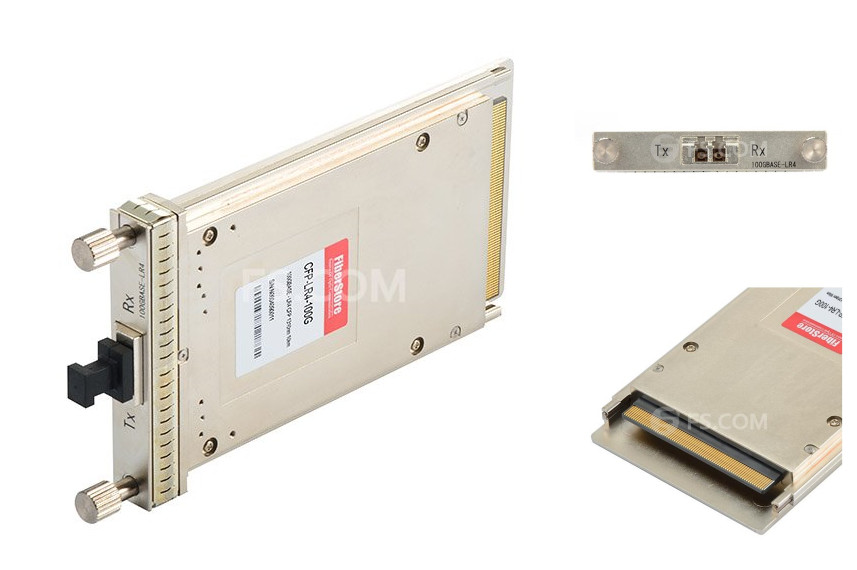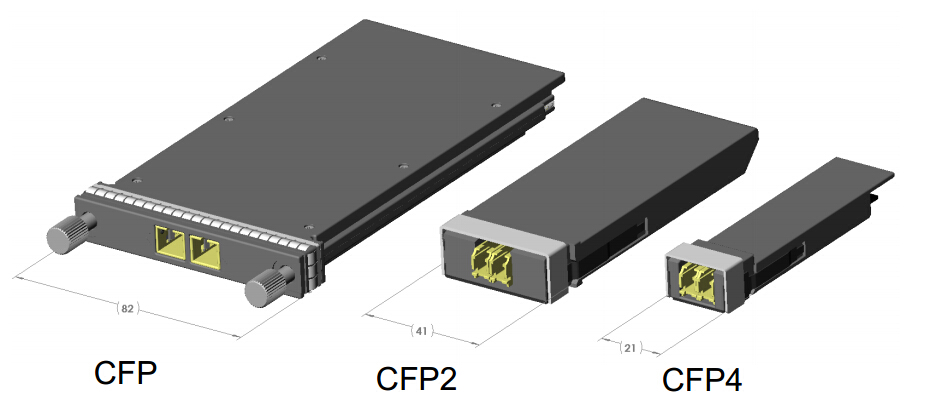May 23, 2016
With rapid development of technologies, 100G Ethernet now has become more and more closer to us. Plug-and-play and hot-swappable optical transceivers play an important role in achieving realiable and effective 100G Ethernet. There are several optical transceiver options for 100G Ethernet networks, such as CFP, CXP and QSFP28. Among them, how much do you know about CFP and CXP? Do you know the difference between CFP and CXP? Is CXP transceiver designed to replace CFP transceiver? Today, this post will help you understand these two kinds of 100G optical transceivers.
CFP (C form-factor pluggable) is a multi-source agreement (MSA) to produce a common form-factor for the transmission of high-speed digital signals. "C" stands for the Latin letter C, which is used to express number 100 (centum). CFP transceiver also supports 40GbE. The CFP MSA was formally launched at OFC/NFOEC 2009 in March by founding members Finisar, Opnext, and Sumitomo/ExceLight. CFP form factor supports both single-mode and multi-mode fiber and a variety of data rates, protocols, and link lengths, including all physical media-dependent (PMD) interfaces in the IEEE 802.3ba standard. For 40GbE, target optical interfaces include the 40GBASE-SR4 for 100 m and the 40GBASE-LR4 for 10 km. There are three PMDs for 100GbE: 100GBASE-SR10 for 100 m, 100GBASE-LR4 for 10 km, and 100GBASE-ER4 for 40 km. The picture below shows a Juniper Networks CFP-GEN2-100GBASE-LR4 compatible 100GBASE-LR4 CFP transceiver.

CFP was designed after the small form-factor pluggable transceiver (SFP) interface, but is significantly larger to support 100Gbps. The electrical connection of a CFP uses 10×10Gbps lanes in each direction (Rx, Tx). The optical connection can support both 10×10Gbps and 4×25Gbps variants. CFP transceivers can support a single 100Gbps signal like 100GE or OTU4 or one or more 40Gbps signals like 40GE, OTU3, or STM-256/OC-768. The CFP-MSA Committee has defined three form factors:
- CFP—Currently at standard revision 1.4 and is widely available in the market.
- CFP2—Half the size of a CFP transceiver, and is available in the market.
- CFP4—Half the size of a CFP2 transceiver, and the standard is not yet available.

The original CFP specification was proposed at a time when 10Gbps signals were far more achievable than 25Gbps signals. As such to achieve 100Gbps line rate, the most affordable solution was based on 10 lanes of 10Gbps. However improvements in technology has allowed higher performance and higher density, contributing to the development of the CFP2 and CFP4 specifications. Note that CFP, CFP2 and CFP4 modules are not interchangable (but interoperable at the optical interface with approriate connectors).
CXP transceiver is targeted at the clustering and high-speed computing markets, so it is usually called high-density CXP. Technically, CFP transceiver will work with multimode fiber for short-reach applications, but it is not really optimized in size for the multimode fiber market, most notably because the multimode fiber market requires high faceplate density. CXP transceiver was created to satisfy high-density requirements of data centers, targeting parallel interconnections for 12×QDR InfiniBand (120 Gbps), 100 GbE, and proprietary links between systems collocated in the same facility. A CXP transceiver is about 45 mm in length and 27 mm in width, making it slightly larger than an XFP transceiver. It includes 12 transmit and 12 receive channels in its compact package, which is achieved by a connector configuration similar to that of a CFP transceiver. Besides, a CXP transceiver enables a front panel density that is greater than that of an SFP+ running at 10 Gbps. Typical applications of CXP transceivers in the data center include 100GE over copper and 100GE over multimode fiber.
Despite having a similar acronym and emerging at roughly the same time, CFP and CXP form factors are markedly different in terms of size, density, and intended applications. Both CFP and CXP optical transceivers are hot-pluggable, and feature transmit and receive functions, and both support data rates of 40 and 100 Gbps. For 40 GbE and 100 GbE applications, CFP transceiver supports both single-mode and multi-mode fiber and can accommodate a host of data rates, protocols, and link lengths. CXP transceiver is targeted at the clustering and high-speed computing markets. These two types of transceiver modules are complementary, not competitive, according to several sources. The existence of CXP transceiver does not mean the replacement of CFP transceiver.
CFP transceiver and CXP transceiver have both similarties and differences. Which one to choose for your applications? It depends. If you need to build a box that can adapt to any interface, you would probably use CFP transceiver modules. If it's a box that is just focused on the short-reach market, then CXP transceiver modules would be preferable options.
Posted by: jowang at
04:32 AM
| No Comments
| Add Comment
Post contains 779 words, total size 6 kb.
35 queries taking 0.0196 seconds, 70 records returned.
Powered by Minx 1.1.6c-pink.









